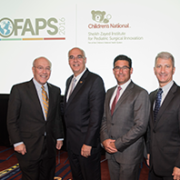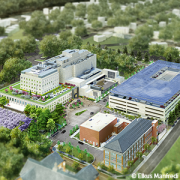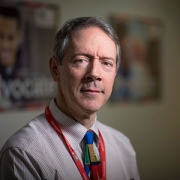3 ways to bring safe surgery to kids in remote regions
On Oct. 10, at the World Federation of Pediatric Surgeons (WOFAPS) Congress, in Washington, DC, the chief executives of four top North American pediatric hospitals held a candid discussion about bridging gaps in access to safe, high-quality surgical care for children everywhere. Below are three key strategies that emerged from the conversation.
1. Deploy innovative technologies
Kurt Newman, M.D., president and CEO of Children’s National Health System, kicked off Monday’s panel by describing a so-called innovation paradox. Game-changing innovations in pediatric medicine, he said, often emanate from both ends of the global development spectrum.
First-world technologies–such as telemedicine and remote robotics–developed in affluent regions are bringing important specialized care opportunities to lower-resourced communities. At the same time, pressures experienced in developing regions to adapt to challenging conditions and resource constraints can lead to creative solutions with implications well beyond the third world.
According to Michael Apkon, M.D., CEO of the Toronto-based Hospital for Sick Children, up to 85 percent of children in the developed world are cared for in emergency departments that have no specific in-house pediatric expertise. For the most part, he said, they are treated in general hospitals by physicians and nurses with no specific training in pediatric care.
In remote areas like rural Ontario, there simply isn’t enough volume to sustain in-house pediatric specialists in every hospital, Apkon explained, “but there’s a big opportunity to provide support from centers that do have that capacity.” Through telemedicine and remote robotics, “we can guide caregivers that are quite capable of doing interventions if they have the right support,” he said.
At the same time, technologies created to meet specific third-world needs are demonstrating potential for broader applications.
Dr. Newman highlighted one such technology – a low-cost, disposable, multifunctional incubator for at-risk, low-birth-weight babies – developed by the Center for Advanced Sensor Technology at University of Maryland Baltimore County. The technology won a major grant earlier this week as part of a device competition at the 4th annual Sheikh Zayed Pediatric Surgical Innovation Symposium.
Though it was developed specifically to help curb preventable deaths within the first week of birth in developing areas, the technology could have cost-reducing applications for hospitals around the world.
2. Provide training opportunities
Richard Azizkhan, MD, CEO of Children’s Hospital & Medical Center in Omaha, spent the early decades of his career working to reconstruct a functioning health care system in post-war Bosnia. A key starting point, he said, was building infrastructure for training and education.
For several years during the war, there were simply no training opportunities for in-country physicians and nurses, he explained. Working with colleagues, Azizkhan set up educational exchange programs and academic centers to teach skills in minimally invasive surgery and other modern techniques. Over time, trainees become trainers, and those skills propagated widely.
“I was training people who ultimately ended up becoming much better than I was,” said Azizkhan. “The first person I trained ended up doing more than 400 cases and becoming a leading trainer for the entire Balkans region.”
Success didn’t happen overnight. “It took literally 20 years to build that infrastructure,” he said. But today the country has capacity for very sophisticated care, including transplants and neonatal oncology.
Dr. Apkon echoed the value of training opportunities for care providers in under-resourced regions.
“Parts of the world that are blessed with the ability to have a specialized system have a moral obligation to help in whatever way they can to create capacity where it doesn’t yet exist,” he said.
Through the SickKids-Ghana Initiative, 1500 nurses in Ghana are being trained to provide very basic services in rural communities that lack a developed healthcare system. The work is aimed at training nurses in foundational elements of holistic pediatric care, including administering treatments for low oxygen, dehydration, and low blood sugar.
3. Build partnerships – locally and globally
In his former capacity at the Cleveland Clinic, Marc Harrison, MD, incoming CEO of Intermountain Healthcare, was tasked with building an entire new multispecialty hospital in Abu Dhabi.
When asked about the key to his success, Harrison didn’t hesitate. “The biggest thing we did right was have the right partner,” he said.
Working with the Crown Prince of Abu Dhabi and many other local partners, Harrison gained insights about how health care is delivered in the region and any societal and political considerations that could impact the hospital’s operations.
“If you’re coming into a new place and are too arrogant to see that there are those who understand the environment better than you, you will fail,” he said. “It isn’t enough to have technical skills or a long track record … if you don’t have the ability to get things done on the ground, you won’t succeed.”
Dr. Azizkhan also emphasized the importance of partnerships – not just locally but globally.
In North America, he pointed out, over 100 institutions are working together to share data and best practices to improve quality and safety across systems. Ventilator-associated pneumonias, central line infections, and surgical site infections, he said, can be dramatically reduced by sharing best practices.
Dr. Newman closed the panel noting, “One thing I’ve found through my career as a surgeon,” he said, “is that the community of cooperation, friendship, and collaboration among pediatric surgeons is unparalleled.”











